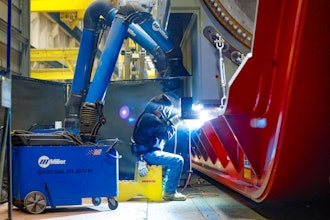
October 7, 2016 was recognized as National Manufacturing Day, an event that hoped to inspire the next generation of manufacturers.
While many companies and associations have special programs surrounding the Manufacturing Day 2016, IEN contributor Miles Parker decided to sit down with Design for Manufacture and Assembly (DFMA) Expert Nick Dewhurst, Vice President of software company Boothroyd Dewhurst to discuss the state of manufacturing from a cost and product simplification perspective.
The interview tackles a perpetual problem faced by engineering staffs: How to simultaneously achieve speedy time-to-market, product performance, and increased cost/profit goals. According to Nick, all three goals can be reached simultaneously.
Miles Parker: What are you seeing in manufacturing today, regarding early stage, analytical product costing? What are the trends?
Nick Dewhurst: The companies we work with at Boothroyd Dewhurst are doing three different things with early stage costing. First off, it is becoming an integral part of new product development projects, where the analysis teams are providing cost feedback to the design teams early in the development stages.
On a second front, companies are using our DFM Concurrent Costing tools to help them, in the later stages of the development of new products, make the correct process choices and production sequences. So they're using it to trade off manufacturing process and material combinations with one another to find the best outcome.
And finally, we're seeing more use in the area of competitive intelligence, where new product development teams are finding value in taking time, early in their own product development processes, to explore what it is their competitors have done in that market space. In some cases they're using DFM to do competitive benchmarking of what those competitive products are likely to cost and whether or not they are going to be able to design and sell their own products at the required margins.
MP: Are you seeing more, or less Design for Manufacture (DFM) and Design for Assembly (DFA) being applied than in the past? Across two decades there has always been some sense of urgency in implementing DFMA. How would you measure that sense of urgency or lack thereof today?
ND: I would say there is less DFA and more DFM—as had been the case for some time. Certainly in the last 10 years there's been a greater push by companies to hurry up and get everything done more quickly.
Product development teams, as a result, are not given the time they need to explore creative design alternatives.
Time-to-market and internal resource pressures get in the way. So DFA is often seen as an activity that they don't have enough time to implement. But they are interested in DFM later on in the process—once the design is finished and parts have been sourced.
Then they will negotiate prices with suppliers using the costs that are coming out of our DFM software.
However, the truly significant money is being left on the table when DFA is not used, and people often don't realize that. They're taking hurried and rushed designs and worrying about buying a dollar piece of sheet metal for 85 cents instead of whether or not that part, for structural reasons, needs to be in the product in the first place.
MP: Is that because they feel comfortable that they've met their margins and now have a product that's functional for the market-and just want to tune up their costs later on?
ND: Actually, I think it's because people are naturally risk-averse. So changing the design of a product that is working seems dangerous and isn't something they're willing to do. But instead, the tendency is to approach the supplier and say, "You're charging me a dollar for this component, and I think it should cost 85 cents."
Companies may get a 15% savings at a piece-part level this way, but at the end of the day it doesn't have a positive impact on throughput and quality at the factory that's producing the product. I do believe it's the short-sided view. It's essentially saying: "Let's take our pennies now, instead of worrying about the dollars we could yield later on."
MP: Is procurement embracing science-based costing? And if not, what are their hesitations and limitations?
ND: We get lots of inquiries from procurement groups within organizations now. Quantitative costing is certainly something that they want to do. However, they typically don't have the technical training to use current science-based costing tools. Again, if you're talking about companies taking the short-sided view, I think that not hiring engineering people in their purchasing departments is another place where tremendous amounts of money are being left on the table by U.S. corporations.
Procurement is still seen within many companies as a paper-pushing exercise: "Here's a packet of drawings, send them out to three suppliers, when the quotes come back pick the lowest one." Instead, those individuals could be doing cost analysis to understand what it should cost to manufacture those parts and then using that good information as the basis for supplier selection and negotiation.
Although it is commonly discussed in procurement circles, there are too few companies that have actually brought engineers onto the full-time staffs of their purchasing groups. But the ones that have hired engineers are accomplishing tremendous things because the teams now understand how to work with the suppliers, and how to talk to them, and how to develop the cost estimates, and use that information to leverage the supply base in positive ways.
MP: A number of veteran DFMA users recommend using DFM should costing—managed by engineering teams with procurement involvement—but with more iterative DFA/DFM done first by the engineers. Should designers be taking a larger role and responsibility in costing and why?
ND: Yes, they should, because the decisions they make when they're developing new concept designs for products go on to impact everything else in that organization for many years into the future. This is a big point of frustration with me and for a lot of the groups that I work with.
The engineering team is being pressured to hurry up and finish their designs, so they don't get a chance to do DFA analysis to explore design alternatives, and yet the company's now hamstrung for the next ten years, producing a design that is terribly inefficient because someone wouldn't take an extra three days in the design process to look at some of the alternative concepts and what those might do to impact manufacturability, cost, quality and everything else that goes on.
So if it were up to me, and I were the CEO of a large company that manufactured electro-mechanical products, I would rely heavily on my design engineering team to produce the most efficient designs that they could, early-on.
I think a forward-looking company realizes that the design decisions individuals are making in the trenches are going to ultimately impact their profitability well into the future.
MP: Tell us about your integration of DFMA data fields with Total Cost of Ownership (TCO.) When did this happen and what outcomes do you expect for industry? How will DFMA and TCO aid in sourcing decisions?
ND: It happened about seven or eight years ago. That is when we casually linked DFA with TCO fields. What companies have finally come around to realizing about DFA and TCO is really the argument that we made about 13 years ago in an article about the hidden costs of offshoring: it's not just the labor you have to measure.
The mantra for 10 years was, "It's 60 dollars an hour here in the US to assemble things, and it's 50 cents an hour in China to assemble things." What people are finally understanding through trial and error is that it's not just about the labor rate. There are a lot of intangible, unquantifiable costs that should be added to the bottom-line cost of that product that's being made in China in order to perform a true apples-to-apples comparison with what’s being made in the U.S. and elsewhere.
Walmart is currently willing to invest $250 billion to revive American manufacturing. I wonder whether they're playing the long game and realizing that low-cost Chinese labor isn't going to continue to bear fruit like it has. And you see that already!
We work with companies all the time that are moving production from China to Vietnam or Thailand, because labor rates in China have become more expensive and the savings that they had been getting simply aren't materializing anymore.
TCO is a direct view into that accounting dynamic. You get to realize all of the things that were missing in a standard analysis that didn't apply overhead and hidden costs to the piece part under bid on the other side of the world.
MP: What outcomes do you expect for industry when they start using TCO?
ND: All of a sudden U.S. manufacturing is going to look a lot more interesting. If a lot of the talk that you hear from both political parties about bringing back jobs starts to be something that gets some engineering and accounting "teeth," then the companies that are ahead of the curve on DFMA and TCO are going to be more successful in their large domestic markets and reap rewards earlier.
MP: Is the engineering argument for domestic manufacturing too technical for the nation to concentrate on? People will be looking instead for changes in our trade agreements, which is critical too. But what if we're stuck with what we've done in those agreements?
ND: It all comes back to that design and accounting team in the end, doesn't it? Those folks spinning the data models in the trenches are making decisions that ultimately dictate the profitability of their business, regardless of trade inequities.
MP: Can DFMA TCO equalize the playing field for advanced industrialized nations competing against low foreign labor rates?
ND: Yes, because of what we just talked about in design and total cost. Allowing a company to come up with those additional total costs, which are associated with low-cost overseas labor, will start to make American manufacturing look more competitive. Thirteen years ago we were arguing that you had to add 24% to do an apples-to-apples comparison between China and the U.S. And I think with thirteen more years' worth of data, companies now realize that the number has grown because labor and related costs have gone up.
MP: Added to what you discussed about utilizing more efficient designs and TCO, we're seeing a national investment in automation that will also reduce labor. How does this contribute in your opinion?
ND: There is a problem waiting to happen in that world, as well. Because if the designers have not taken the time to design those products for ease of assembly by hand, you're going to have a heck of a time to get automatic equipment or a robot to put your products together.
MP: Are customer requirements being considered accurately by manufacturers? Do customers lose in the cost reduction exercises?
ND: Companies that are taking an undisciplined approach to cost reduction are generally de-featuring and cheapening products in order to offer them at lower costs. What going through a DFMA exercise allows you to do, especially with the addition of our new functional groupings in the software, is identify what things are important to the customer (the functions that they value and the ones they don't), and then you can assign parts within your DFA analysis to each of those function groups.
It's a really powerful thing to be able to look at because you can change the design to reduce the amount of money spent on features that they don't care about, and thereby increase the amount of resources available for areas that are valued.
MP: Achieving time-to-market, product performance, and cost goals were discussed at the 2016 DFMA Forum as not being exclusive of each other. Can organizations have all three objectives realistically met?
ND: Yes you can, with appropriate resource allocation to upfront design. An investment in upfront design time is going to be the thing that helps you achieve all three of those factors.
It's long been established that 70% of the cost of the product is locked in in the design phase. You better make sure that you're asking the right questions and making the right decisions during that development phase in order to lock in the lowest possible 70% of the cost. Fewer parts lead to enhanced quality and there's less material to drag through your product development process.
So time-to-market is speeded by part-count reduction in upfront design. It all comes back to that investment in upfront design time and getting people to think critically about the designs of their products with an eye to part-count reduction.
Simply doing that would get a lot of organizations well on their way to achieving what seems impossible to them today, which is to bring products to market more quickly, at lower cost, and with higher quality.





















